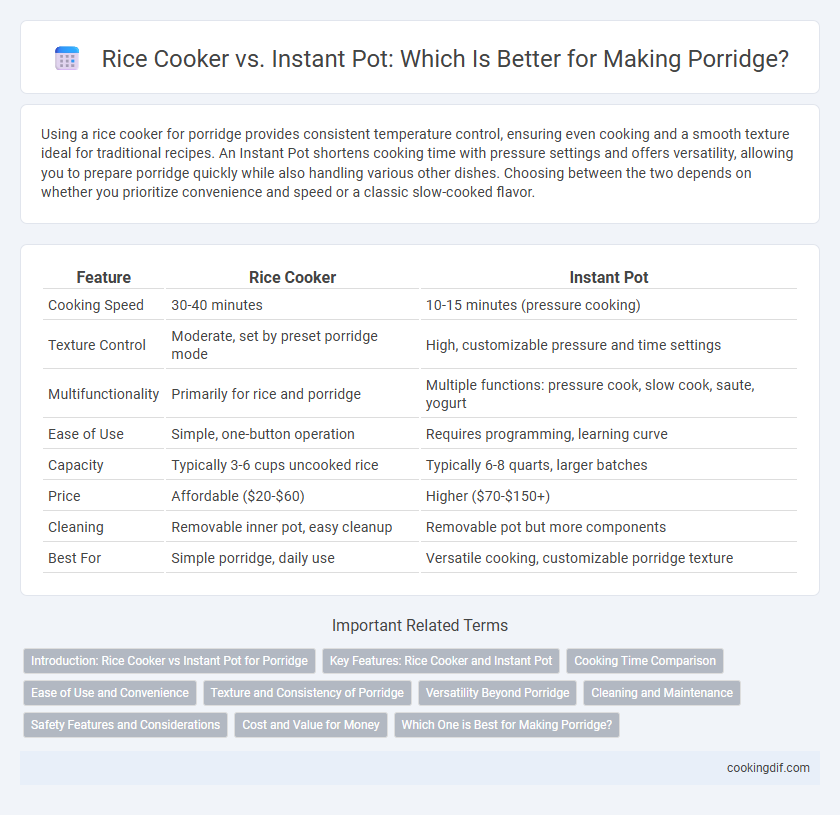Using a rice cooker for porridge provides consistent temperature control, ensuring even cooking and a smooth texture ideal for traditional recipes. An Instant Pot shortens cooking time with pressure settings and offers versatility, allowing you to prepare porridge quickly while also handling various other dishes. Choosing between the two depends on whether you prioritize convenience and speed or a classic slow-cooked flavor.
Table of Comparison
| Feature | Rice Cooker | Instant Pot |
|---|---|---|
| Cooking Speed | 30-40 minutes | 10-15 minutes (pressure cooking) |
| Texture Control | Moderate, set by preset porridge mode | High, customizable pressure and time settings |
| Multifunctionality | Primarily for rice and porridge | Multiple functions: pressure cook, slow cook, saute, yogurt |
| Ease of Use | Simple, one-button operation | Requires programming, learning curve |
| Capacity | Typically 3-6 cups uncooked rice | Typically 6-8 quarts, larger batches |
| Price | Affordable ($20-$60) | Higher ($70-$150+) |
| Cleaning | Removable inner pot, easy cleanup | Removable pot but more components |
| Best For | Simple porridge, daily use | Versatile cooking, customizable porridge texture |
Introduction: Rice Cooker vs Instant Pot for Porridge
Rice cookers provide a simple, reliable method for making porridge with consistent temperature control and minimal supervision, ideal for basic recipes. Instant Pots offer advanced multi-functionality including pressure cooking, which significantly reduces cooking time while allowing customization of texture and ingredients. Choosing between a rice cooker and an Instant Pot depends on convenience preference, cooking speed, and desired porridge consistency.
Key Features: Rice Cooker and Instant Pot
Rice cookers offer a simple, one-touch operation with preset porridge settings, ensuring consistent texture and ease of use. Instant Pots provide multi-functionality, combining pressure cooking and slow cooking, reducing cooking time significantly while allowing customizable porridge thickness. Both devices feature keep-warm modes, but the Instant Pot's advanced controls and faster cooking make it ideal for versatile porridge recipes.
Cooking Time Comparison
Cooking porridge in a rice cooker generally takes between 30 to 60 minutes depending on the grain type and quantity, while an Instant Pot can significantly reduce this time to roughly 10 to 20 minutes through pressure cooking. The Instant Pot's precise temperature control and pressure settings enable consistent texture and faster cooking of rice, oats, or mixed grains used in porridge. Rice cookers are simpler with fewer settings but may require longer soaking or natural steaming periods, making the Instant Pot a superior choice when efficiency and speed are priorities.
Ease of Use and Convenience
Rice cookers provide a straightforward, one-touch operation for making porridge, ideal for users seeking simplicity and minimal monitoring. Instant pots offer multi-functionality with programmable settings, enabling quicker cooking times and the ability to switch between porridge, slow cooking, and sauteing modes. Both appliances enhance convenience, but rice cookers excel in ease of use while Instant pots deliver versatility and faster results.
Texture and Consistency of Porridge
Rice cookers produce a smooth and evenly cooked porridge with a consistent texture due to their steady, low-heat cooking process, which prevents burning and ensures thorough absorption of liquid. Instant Pots offer more control over cooking time and pressure settings, resulting in a thicker, creamier porridge with a richer texture by breaking down grains faster under high pressure. Choosing between the two depends on preference for either delicate, uniform porridge (rice cooker) or a heartier, denser consistency (Instant Pot).
Versatility Beyond Porridge
Rice cookers provide reliable, consistent cooking for porridge with preset functions but are generally limited to simpler tasks like steaming and slow cooking. Instant Pots offer greater versatility by combining pressure cooking, sauteing, and slow cooking, allowing for more complex porridge recipes and other dishes such as soups, stews, and rice varieties. The multi-functionality and programmable features of Instant Pots make them ideal for users seeking an all-in-one kitchen appliance beyond just making porridge.
Cleaning and Maintenance
Rice cookers typically have non-stick inner pots that are easier to clean and maintain compared to Instant Pots, which involve multiple components, including sealing rings and lids that require thorough cleaning. Instant Pots demand regular inspection and cleaning of the steam release valve and gasket to prevent residue buildup and ensure safety. Overall, rice cookers offer simpler maintenance, while Instant Pots require more detailed cleaning to sustain optimal performance for porridge preparation.
Safety Features and Considerations
Rice cookers offer straightforward safety features such as automatic shut-off and overheat protection, making them reliable for porridge preparation. Instant Pots include advanced safety mechanisms like lid lock, pressure regulation, and temperature control, which prevent accidents during high-pressure cooking. Choosing between the two depends on the level of safety assurance preferred, with Instant Pots providing more comprehensive protection for varied cooking modes.
Cost and Value for Money
Rice cookers generally offer a lower upfront cost than Instant Pots, making them a budget-friendly option for preparing porridge. Instant Pots provide multifunctionality, including pressure cooking and slow cooking, delivering greater value for money through versatile meal preparation beyond porridge. While rice cookers are specialized and simpler, Instant Pots justify their higher price by combining multiple appliances in one, appealing to users seeking efficiency and convenience.
Which One is Best for Making Porridge?
A rice cooker excels at delivering consistent, evenly cooked porridge with minimal effort, making it ideal for traditional porridge recipes that require steady heat and simple settings. The Instant Pot offers greater versatility and faster cooking times through pressure cooking, allowing for richer flavors and varied textures in porridge, especially when incorporating additional ingredients like beans or meats. For straightforward porridge preparation, a rice cooker is best, while the Instant Pot suits those seeking complexity and speed in their porridge cooking.
Rice cooker vs Instant pot for making porridge Infographic

 cookingdif.com
cookingdif.com